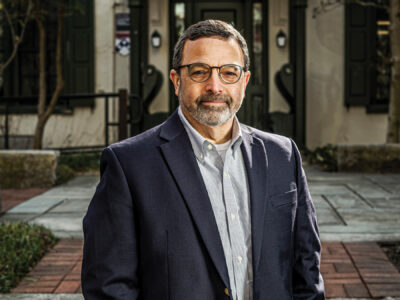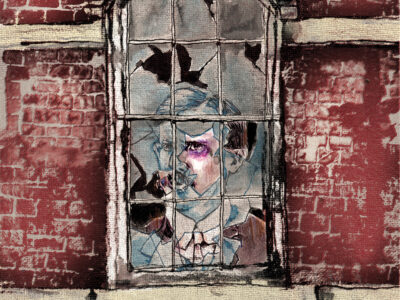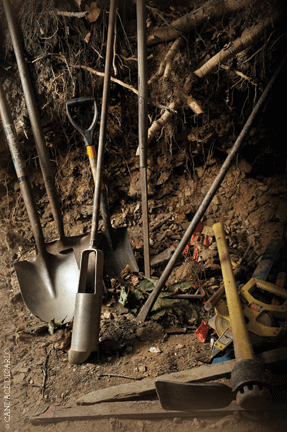
In the summer of 1832, 57 Irish laborers died suddenly while building the first railroad in Pennsylvania. Alumnus Bill Watson and a host of other Penn people have been trying to find out what really happened. And they’re getting close.
By Samuel Hughes
Photography by Candace diCarlo
Sidebar | In the Midst of Life …

Think of a jigsaw puzzle, made up of thousands of pieces. It depicts a wooded valley and a tree-lined embankment leading up to a railroad line. Now imagine that it’s three-dimensional, with tulip poplars rising into the sky, their roots reaching deep into the soil for nutrients. Then add another dimension: time, warping back like a Möbius strip into the early 1830s and curving around to the present. Finally (and the staunchly empirical can skip this part), cover it all with a nebulous fabric, which the dead pass through to seek out the living.
Now shake it up and throw the pieces out into the woods. Then try to reassemble them, in the dark.
No one alive knows exactly what happened during that searing August of 1832 in the rough slice of southeastern Pennsylvania known as Duffy’s Cut. This much is clear: 57 Irish laborers who had been constructing a particularly difficult stretch of the Philadelphia and Columbia Railroad between Malvern and Frazer died suddenly in that rural valley, two months after many of them had arrived in Philadelphia on a ship from Derry. Their bodies were buried hastily in the dirt and gravel fill that would soon support railroad tracks.
For more than 170 years, on the rare occasions that the deaths were mentioned at all, they were attributed to the outbreak of Asiatic cholera that had swept through the region, killing thousands. Now, after several years of poking around and several more of focused digging, it’s become increasingly clear that something more sinister happened as well.
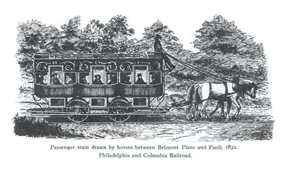
The best way to get to the Duffy’s Cut dig site these days is to park your car on a cul-de-sac in a certain Malvern housing development (tipping your hat to the residents for their patience), then walk down a hill and cross a small stream that runs through the wooded valley. Thirty or 40 more yards over a low wooded ridge and you’re there.
The site cuts into the steep embankment, where a massive, twin-trunk tulip poplar thrusts up between the denuded, squared-off digging units. Higher up the fill and a few yards to the north run the Amtrak and SEPTA tracks.
“There’s a saying that under every mile of track is a dead Irishman, here on the East Coast,” says William Watson G’86 Gr’90. “And that seems to be the case here. They died building something of great consequence—this was the biggest industrial endeavor in Pennsylvania, the second railroad in North America. And their story needs to be told.”
Watson, cheerfully rumpled in a Duffy’s Cut T-shirt and jeans, is sitting in his cluttered office at Immaculata University, a small Catholic college near Malvern, where he is professor and chair of history. For the past eight years he’s been the driving force behind the Duffy’s Cut Project, which seeks to find out just what happened to those Irishmen, and why. Immaculata is now sponsoring the project, but for years Watson and his colleagues were footing the bills for this obsessive labor of love.
A couple of hours earlier, he and a group of the usual student suspects were digging at the site, which is roughly a mile from his office. Though they didn’t find anything this morning, it was still a productive summer: In July they unearthed two new sets of remains whose skulls revealed clear evidence of peri-mortem trauma—a clinical way of saying that they had died violently. That brought the total number of remains to seven.
On another level, the summer was brutal. Historian John Ahtes C’84 G’84, Watson’s good friend and a key member of the project from the beginning, died July 11 of a burst aorta. He was 48 years old. “I have lost my best friend and an irreplaceable pillar,” said Watson, who had been on the phone with a seemingly healthy Ahtes the night before, talking about the remains they had just found and their upcoming classes. (See sidebar on page 41.)
Watson and Ahtes spearheaded the University’s contribution to this remarkable project, though they are by no means the only Penn-affiliated members of the informal team. Janet Monge Gr’91, a forensic anthropologist at the Penn Museum and an adjunct associate professor of anthropology [“Justice in the Bones,” Nov|Dec 1999], has provided invaluable expertise in deciphering the cryptic clues provided by skulls and bones. Samantha Cox C’10 G’10, a graduate student with archaeological experience in ancient Italian cemeteries, has been cracking the whip as on-site supervisor, transforming the dig from a rather chaotic, amateurish site to one that can pass professional muster. And if it hadn’t been for geophysicist Tim Bechtel, a lecturer in the Department of Earth and Environmental Sciences, and his sophisticated ground-penetrating radar (GPR), they might still be looking for their first skeleton.
From the beginning, Watson and Ahtes were joined by Watson’s twin brother, Frank, a Lutheran minister; Earl Schandelmeier, an amateur historian and former student of Bill’s; and a shifting group of students and interns and other diggers. (More recently they’ve been joined by a forensic dentist named Matt Patterson.) The story has evolved from a local affair reported by area papers and TV stations to one covered by media ranging from the Guardian and the Irish Echo to Smithsonianmagazine and CNN. An Irish film company, Tile, is producing a follow-up version to its 2006 The Ghosts of Duffy’s Cut, which is the same title as the book published by Praeger that year and co-written by the Watsons, Ahtes, and Schandelmeier. (A new book is also in the works, to be titled The Men of Duffy’s Cut.)
“There’s a lot of cases of people getting ground up in the Industrial Revolution,” says Watson. “But there are so few cases of a personal history being recovered. For a lot of people in Ireland, this is important, because they knew individuals in their own lineage had the same experience—they were never heard from again after arriving in America.
“We all know that if circumstances had been different, it would have been us buried there, or our sons buried there,” he adds. “It hits home on a personal level when you realize these guys were, like, 20 years old. They come over here and try to get the American Dream and—boom!—they’re snuffed out, six to eight weeks on arrival.”
By the time the John Stamp arrived in Philadelphia from Derry on June 23, 1832, Pennsylvania had embarked on an ambitious public-works program that would link Philadelphia and Pittsburgh by railroad and canal. The Main Line of Public Works—a response to the Erie Canal to the north and the Baltimore & Ohio Railroad to the south—included the 82-mile Philadelphia and Columbia Railroad (P&C). In March 1828 the state legislature appropriated the massive sum of $2 million to start the project, which would run between Columbia (on the east bank of the Susquehanna River) and Philadelphia—and which, its supporters hoped, would be completed in two years.
Contracts for the railroad were parceled out by the mile, and by June 1829 a contractor named Philip Duffy was reported by the American Republican newspaper to be “prosecuting his Herculean task with a sturdy looking band of the sons of Erin.” The Irish-born Duffy, who spoke Gaelic as well as English, would meet incoming ships at the Philadelphia docks and hire the new arrivals to work on the railroads.
“Philip Duffy, to me, reflected a kind of a sinister character,” says Bill Watson. “Frank and Earl have a somewhat more middle-of-the-road interpretation of him as a labor contractor. He wanted to earn a maximum profit, and I don’t think he really cared whether these guys lived or died. So he was an exploiter of his own countrymen.”
In the 1830 census Duffy was listed as renting a house in Willistown, Chester County, and had 20 men between 20 and 30 years of age living with him, 10 of whom were described as “aliens, foreigners, non-naturalized.”
Some of those aliens may have been among the crew constructing Mile 59, which included an area between Malvern and Frazer known as Dead Horse Hollow. In order to bridge a “chasm” of 50 to 80 feet, the men had to construct an earthen fill that would eventually stretch more than 100 yards. That hill, which became known as Duffy’s Fill or Duffy’s Cut, still supports that part of SEPTA’s Paoli/Thorndale line and Amtrak’s Keystone Corridor, though they run a few yards to the north of the old P&C tracks.
While the Mile 59 crew would have been made up of 100 to 120 men, only about half lived at Duffy’s Cut, where they slept in a large shanty built on the ravine’s west side and were paid about 50 cents a day, plus whiskey. The average contract to build a mile of railroad was between $4,000 and $6,000 in the 1830s; Duffy’s contract for Mile 59 was for $23,000—and even that fell far short of the final cost of $32,000.
By August 1832, the work was already behind schedule, and Duffy himself was losing money. But that was hardly the most serious problem he was facing.
It started in India, probably in the Ganges River delta. At the time, most physicians believed that cholera was caused by bad air, a theory that seemed to be confirmed by the high casualty rates in poor, malodorous neighborhoods. In fact, it’s spread mostly by human fecal matter in drinking water. Once the Vibrio cholerae bacteria settle into the intestines, they release toxins that prevent the body from absorbing water; its symptoms include severe abdominal pain, massive diarrhea, and vomiting. Death, from extreme dehydration and shock, comes swiftly to 40 to 60 percent of its victims.
The second cholera pandemic would kill an estimated 150,000 people around the world, and by the summer of 1832 it had reached North America. On July 7, the first case of cholera appeared in Philadelphia. By the week of August 4-10, 830 cases and 326 deaths had been recorded. The pandemic also coincided with the “first large waves of Irish Catholic immigrants in Pennsylvania,” as Watson noted in an article for U.S. Catholic Historian. The implications of that timing were potentially combustible. “Irish Catholics were understood in Protestant America to be the agents of the infection of Popery and subversion,” Watson and his colleagues noted in The Ghosts of Duffy’s Cut; “when they were also perceived to be the agents of infection with cholera, any result is imaginable.”
A Chester County newspaper, the Village Record, had already warned that the failure to “preserve a good understanding between the people living adjacent to the route, and the contractors and hands employed in the work … has been the fruitful source of disorders and riots in some parts of the country.”
Disorders and riots were no empty words. In 1831 a mob burned St. Mary’s Church in New York, and in 1844 the Philadelphia Nativist Riots led to numerous deaths and injuries and the burning of St. Augustine’s Church.
When cholera struck at Duffy’s Cut in mid-August, “most of the workmen fled from the infected shanty at once,” wrote Julian Sachse in an 1889 newspaper article that drew on the local residents’ memories, “but so great was the fear of the surrounding population, that ever [sic] house was closed against fugitives, no one was found willing to give them food or shelter.” It now appears that the fear-driven reaction among the neighboring population was more violently pro-active than that.
“We’ve always had suspicions, because of the 100-percent casualty rate,” says Watson. “There should have been a couple of those guys who survived. The railroad file says that the men tried to flee and were forced back into the valley. So those guys died outside of the valley, and were brought back in. And the other guys are kind of in an enforced-quarantine scenario—forced back into the valley to die.”
Whether the men who tried to flee were sick themselves or simply trying to escape the site is unknowable. Either way, Watson believes that they were turned back—violently—by local vigilantes. His money is on the East Whiteland Horse Company, whose business was catching and punishing horse thieves, and whose principals included the owners of the property that abutted Mile 59. But his evidence is, so far, circumstantial at best.
A few heroes did emerge. One was a local blacksmith in Duffy’s employ whose name was probably Malachi Harris.
“When all fled he alone remained and ministered to the sick,” wrote Sachse, “and when the scourge claimed its first victim … he laid the man out as decently as he could, dug a grave single-handedly … then returned and dragged the corpse over to the opposite side of the ravine and buried it.”
Then there were the four Sisters of Charity, a Catholic order whose members served as the “essential caregivers” (Watson’s words) of the 1832 epidemic in the Philadelphia area. Sent by church authorities “to attend to the sick and dying in the shanty in the ravine,” as Sachse recounted, the four were taken by stagecoach to the Green Tree Inn between Paoli and Malvern, but that was “as near the infected spot as the driver could be induced to go.” They walked the rest of the way to Duffy’s Cut, where they administered to the dying men as best they could—then were forced to walk the entire way back to Philadelphia in the blazing heat, “so great was the fear of contagion” among local residents and stagecoach drivers.
It isn’t clear where Philip Duffy was when the epidemic struck—he may have been overseeing a section of the West Chester Rail Road for which he had also contracted—but when he heard that all were dead, he ordered the blacksmith to “set fire to all the buildings and utensils on the ground.” Soon a new crew was hired, and work was resumed, whereupon “the common grave was rounded up and a rough slam placed over the bodies of the unknown dead.”
Though the local newspapers did report an outbreak of cholera among the railroad workers, only eight or nine deaths were noted. One paper, the Village Record, even wrote a retraction to an earlier story (the issue has disappeared from the Chester County Historical Society’s archives), saying that “to prevent exaggeration, we deem it proper to state, that on the Railway … a fortnight ago, several cases of Cholera occurred, eight of which proved fatal—it then ceased suddenly as it commenced.” The paper added that the whole railroad line “has been, through the summer, with the few exceptions noted, remarkably healthy.”
A few months later, however, P&C Superintendent William Mitchell acknowledged that Duffy had been in “great difficulty and distress” on account of the fact that “nearly one half of his men died of Cholera.” That did not prevent Mitchell from calling the contractor a “perfect master of the art of complaining with or without cause.” No one ever said the Industrial Revolution was gentle.
Duffy was a wealthy man by the time he died in 1871 at age 88. His mansion still stands at 40th and Pine streets in West Philadelphia.
“We often wonder what it was like for him in his later years, as he’s sitting out on his porch,” says Bill Watson. “Is he pondering what had happened? Or is he just counting his money?”
Others remembered, quietly. In 1870, a group of railroad employees led by one Patrick Doyle built a small picket fence, within sight of the current tracks, as a memorial to the dead. By then the tracks had already been moved a few yards to the north by the Pennsylvania Railroad (PRR), which bought the P&C in 1857. In 1909, Martin Clement, a PRR supervisor who would later become president of the railroad, replaced the fence with a square-shaped memorial wall made from stones that had supported the original tracks. After that, apart from modest individual efforts, the world pretty much forgot about Duffy’s Cut.
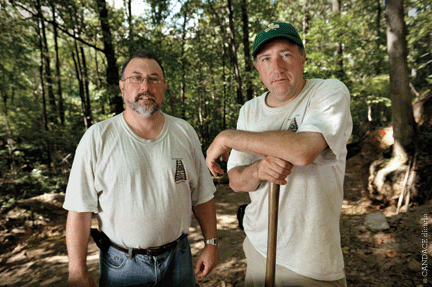
When Bill and Frank Watson were boys, their grandfather, Joseph Tripician, sometimes told stories at Thanksgiving dinner about the old days on the railroad. Tripician, a talented Sicilian immigrant, had spent five decades working for the Pennsy, including a number of years as assistant to President Clement.
One of the tales he told was a ghost story that had to do with some place called Duffy’s Cut, Bill remembers. “But I didn’t pay much attention.” He was more interested in his grandfather’s discussions of ancient and medieval history, which would later become the focus of his graduate work at Penn under Edward Peters, the Henry Charles Lea Professor of History.
But around 10 in the evening of September 19, 2000, Bill saw something from a bathroom window that he has never been able to explain in a way that comports with the usual storylines of the Academy.
Both Watson brothers moonlight as bagpipers in their spare time—sometimes on Penn’s campus—and after a piping gig in Lancaster, Bill and fellow piper Thomas Conner stopped at Watson’s Immaculata office to use the facilities. Through a rectangular, south-facing window, Conner interrupted their small talk: “Billy, what am I looking at?” Watson, standing in another stall, asked him to describe the scene. From Conner’s verbal description, Watson dismissed it as probably “someone’s idea of art,” a neon light show or some such. Then he stepped over to the window and looked out.
In his book he writes that he saw “three illuminated figures standing perfectly still, facing us. They looked like thin human forms with legs stretched out in a ‘V’ and arms pointing to the sides. Their ‘heads’ looked like they were only addendums to the torsos. They were completely illuminated in the dark field outside the bathroom, and my nearest approximation was that they were neon lights.”
Neither man was particularly alarmed—until the figures suddenly vanished, at which point the two men skedaddled out of the bathroom. When they went outside and looked around, Watson says, “there was absolutely nothing there.”
The next day, he began asking around to see if any of his colleagues had heard any stories connected with the college grounds. They hadn’t. Nor had anyone heard about any sort of light show the night before. Not wanting to ruin his reputation by sounding like a lunatic, Watson dropped the subject, and pretty much forgot about it.
Fast-forward to Labor Day weekend 2002. Bill and some other Watson family members had gathered for a cookout at Frank’s home in Freehold, New Jersey. Bill had brought a pile of files that had belonged to their Grandfather Tripician, and when they finished divvying up all the old railroad photos and newspaper clippings, Frank brought out something that their grandmother had given him after Grandpa Tripician passed away.
It was PRR file # 004.01 C, and it concerned something called Duffy’s Cut.
“I took one look at it and realized it was a hidden history connected to the very area where I had gotten a job” at Immaculata, says Bill. “I knew I had to find that spot.”
Then something in the file caught his eye. It was the newspaper story from June 1889 by Julian Sachse titled “The Legend About Duffy’s Cut On the Pennsylvania Railroad Between Malvern and Frazer.” Transcribed on PRR letterhead as part of the official file, the story included a lengthy interview with an elderly area resident.
On a “warm murky night” in September 1832, just weeks after the Irishmen had been buried, the man recounted, he had been returning from the Green Tree Inn and was walking along the railroad. When he came to Duffy’s Fill, he told his interviewer:
… the night was hot and foggy, so I trudged up between the stone blocks [the railroad sills, on which the tracks were laid] until I got on the fill, and there I [saw] with my own eyes the ghosts of the Irishmen who died with the cholera a month ago, a dancing around the big trench where they were buried … They looked as if they were a kind of green and blue fire, and there they were a hopping and bobbing on their graves.
Sachse gently challenged the elderly resident, but the man insisted that “what he had seen were the disembodied spirits of the laborers who were buried in the trench.” And, he added: “I hadn’t been drinking no whiskey either that night.”
As soon as he read that story, Bill called his bagpiping friend Tom Conner and said, “I think I may have an explanation for what we saw that night.”
File # 004.01 C—prosaically titled “History of ‘Duffy’s Cut’ Stone enclosure east of Malvern, Pa., which marks the burial place of 57 track laborers who were victims of the cholera epidemic of 1832”—was not supposed to be seen by outsiders. (A nephew of Clement’s recently told Bill Watson that as late as 1959, the PRR president “was telling people to keep it secret,” Watson recalls. “He remembers being called into Clement’s office to see this file—my grandfather was present—and he said, ‘This is what happened here, but you’re not to tell anybody.’”)
As the title made clear, the railroad’s own investigation concluded that 57 men—not eight or nine—had died, and the correspondence from PRR employees included some illuminating tidbits about the possible location of the bodies and the existence of primary-source materials. (One brief note says simply: “Miss Ogden says that her sisters diary shows entry in August 1832 she died of cholera at Fraser.”)
In a way, it’s surprising that the file exists at all. After all, why would a rising executive in a powerful corporation like the PRR put together a file of material related to disease and death along the railroad lines, and which might even lead to revelations of murder?
As Bill Watson tells it, there was a human connection that began in 1909 when Clement, then assistant supervisor at Paoli, was living in Malvern with an Irish family named Donahue.
“George Donahue’s wife, Bridget Doyle, was the sister of Patrick Doyle, the guy who put the first fence up at the site in 1870,” he explains. “So Clement heard about it from him. Doyle probably learned about it from the blacksmith, Harris, who was back in the area a couple decades later providing water and ballast for the railroad.”
Clement, who became president of the railroad in 1935, has evolved in Watson’s mind from a controlling, faintly sinister character who had kept the file secret to a sympathetic figure who had kept the story alive but had to keep it secret. (There were, Watson says, “well-placed people involved in this.”)
The whole story “would have been lost to history without Clement,” adds Frank. “He’s a key figure in making sure the story was preserved.”
Incidentally, when Clement had the stone wall built in 1909, he proposed that a plaque be attached to it with the words: 57 men are buried here. Died with the cholera during the construction of the road in 1832. The proposal was turned down by the railroad as too expensive.
Bill Watson returned to Immaculata on fire, the Duffy’s Cut file in hand. Earl Schandelmeier, then one of his students, remembers him making a general request for volunteers to go to the Chester County Historical Society to start verifying the file’s contents. “I don’t volunteer for anything, but I did for this,” says Schandelmeier, who began scouring the archives for copies of the local papers from 1832. Watson also recruited John Ahtes, his friend and fellow Penn graduate alum, whom he had just hired to teach Irish history at Immaculata.
Their first goal was to find the stone memorial that Clement had erected, and for the next few weeks they spent the time between classes trudging through the woods and weeds near the tracks. On Columbus Day 2002, the Watsons and their bagpiping friend Tom Conner found the memorial—slightly overgrown but otherwise in good condition.
Their next step—getting an official Pennsylvania state historical marker for the site—required a lot of paperwork and letters to clout-wielding politicians. But by June 2004, having enlisted grass-roots Irish organizations and politicians ranging from State Senator John Rafferty to US Senators Arlen Specter and Rick Santorum, they had themselves a marker at the corner of King and Sugartown roads, about a quarter of a mile from the actual site.
The next goal was to see if they could find the site of the shanty. (Finding the actual remains of the Irishmen, they knew, was the longest of long shots.)
Their first efforts, using metal detectors and the like, were pretty amateurish.
“When we initially went into the valley, it was with the rudest of implements,” says Schandelmeier. “We were kicking aside leaves to see what we could see, then looking at railroad maps and property maps.”
Aided by the canine crew from the Philadelphia Search and Rescue Team, they found enough ash to indicate a long-ago fire. Soon they uncovered a cooking pot, forks, a large metal spoon, glassware, pottery shards—and pieces of clay pipes, including one with the word Derryembossed on it, and another bearing a harp flag and the words Flag of Ireland. Those artifacts helped paint a picture of working life along Mile 59, and buoyed the spirits of the diggers. They also brought the project some good press. But they weren’t human remains.
Even the PRR file contained conflicting information about where those might be. In 1909, someone had written an article in the Daily Local News suggesting that the workers were buried under the modern tracks, slightly to the north of the old P&C tracks. If that were the case, the bodies would never be found. But that same year a railroad worker named George Dougherty told the investigators that he had heard his father say that the men “were buried where they were making the fill” for the original tracks. (The elder Dougherty had been born in Donegal in 1809, the Watsons discovered, making him a contemporary of the workers; he was also living in the Frazer area at the time of the epidemic.)
The theory that they were somewhere under the original tracks not only lent itself to hope; it also made the most sense, argues Frank Watson.
“Why would [Harris] have lugged the rest of the bodies further to the north to an area not being built?” he asks pointedly. The 1832 fill “had to be completed in the next year, and that was the best way to bury them.”
With no archaeologist at the site during those early efforts, the team’s first few years of digging were on the haphazard side. When they finally found some bones in 2006, they excitedly turned them over to Janet Monge for analysis.
“I unfortunately had to tell them they were not human bones,” says Monge. They were pig bones, and while the pigs may have been part of the workers’ diet, they were not what the Duffy’s Cut Project was hoping to find.
By the end of 2008, six years after the PRR file had fallen into their hands, they still had not found any dead Irishmen. What they had were, in Bill Watson’s words, “a lot of holes to nowhere.”
“I did not believe we would find those men,” says Schandelmeier, and at one point he finally sat down with Bill and gave him a detailed analysis of why they would never find the bodies, which were probably under the current railroad tracks. But his attempt to give Watson a reality check didn’t work.
“To his credit, the guy does not give up,” says Schandelmeier. “He just would not let it go. He’s an excellent motivator that way. Like the movie Holes, he just kept digging.”
It was a “convergence of folklore and railroad memory and science,” in Bill Watson’s words, that brought them to that spot on the old fill. The folklore part was the elderly resident’s ghost story, and whether or not you buy into the supernatural aspects, it does mark the spot where contemporary observers believed the burial site to be—one confirmed by the 1909 railroad memory of George Dougherty. The science part was Tim Bechtel, principal geophysicist for Enviroscan (a Lancaster County-based firm specializing in geophysical investigations), and his ground-penetrating radar. Bechtel had been recommended to Watson by Andrew McGhie, associate director of Penn’s Laboratory for Research on the Structure of Matter, and was immediately hooked on the Duffy’s Cut Project, which in his opinion is “one of the most fascinating archaeological sites in the country.”
“Before we focused on this area, we had worked all up and down the valley,” says Bechtel, standing on the hillside above the digging area. “The guys had already figured out where the camp was, over here inside those orange flags, but we didn’t know where along here, or even on which side of the valley, the [remains] were going to be.”
“Tim was standing there on the fill, and Frank had the [PRR] file with him,” says Bill Watson. “And Tim says, ‘Let’s open up the file and see what’s in there about the fill and where they’re making the fill.’” When the Watsons pointed out that he was standing on the fill, “he decided to do his image here.”
After planting several dozen electrodes (steel spikes hooked together by cables), Bechtel shot electric currents through the hillside.
“We found a big resistive area in here,” says Bechtel, pointing to a colorful mass on the screen of his earth-resistivity meter. “I think it’s related to all the air pockets,” which he suspected were created by the decaying and collapsing remains. Unlike the damp soil, air is “very resistant” to electrical current.
For Samantha Cox, the location of the large anomalies Bechtel had located was intriguing, to say the least.
“When we went out there the first time, Tim was saying, ‘Oh, yeah, we have this giant anomaly right here, and we have another one right up here,’” she says. “I looked at it, and I was like, ‘That’s exactly where those trees are.’ Those two trees are bigger than any of the other trees around there, and I know they grew there because that’s where the graves are.” She pauses to let that sink in. “Lots of nutrients.”
For archaeologists, especially amateur ones dependent on unpaid volunteers, the site “presents quite a few challenges,” she adds. “It’s on an incredibly steep hill that makes moving dirt much more difficult—not to mention that the incline means that we have to move a lot more earth than we might have had to otherwise. It’s also located in a dense forest with big trees that we have to work around.” Then there’s the fact that the damp, acidic soil of southeastern Pennsylvania is the enemy of old bones.
When they got the intriguing GPR reading from Bechtel, it was the dead of winter and the ground was rock hard. But by March 2009 the earth had softened enough to let them resume digging. Finally, a few days after St. Patrick’s Day, one of the regular volunteers named Bob Frank hit what he describes as “weird colored soil, different from anything else” they had seen. There was something else: coffin nails. Then a tibia. Then a vertebra. And finally a section of very old track, just inches from a human skull.
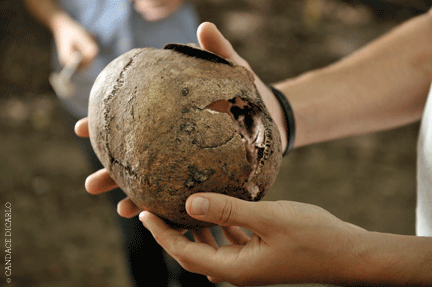
SK001 is trying to tell us something. So are his comrades, SK002, SK006, and SK007. (SK003, -004, and -005 have kind of fallen to pieces, so we’ll leave them alone for now.) I don’t speak Skull, so I’ve asked Janet Monge to translate for me. Which is why she’s eyeballing the cranium of SK001 like Hamlet contemplating the skull of Yorick.
SK001 is saying My name is John Ruddy, Monge thinks. But she’s not positive.
Eighteen-year-old John Ruddy was the youngest of the young men from Donegal, Tyrone, and Derry who sailed to Philadelphia on the John Stamp in June 1832. From the unfused, zig-zag stitching along the skull that indicates immature facial development, Monge has deduced that SK001 was a very young man. Other features suggest that he had also suffered from chronic ear infections and some “stressful phases” in his growth and development by the time he died.
He’s also missing his first molar, a one-in-a-million congenital trait shared by quite a few members of the Ruddy family of Ireland.
“I’m hesitant to say it’s really John Ruddy,” says Monge. “But at the moment, that seems like not a bad guess.” The next step involves DNA testing with Ruddy relatives.
Whoever he is, SK001 seems to have been “bonked on the head,” as Monge puts it for us laymen. There’s a “little diddle” on his skull, she explains, which suggests peri-mortem trauma, even if it’s not exactly conclusive.
SK002 has a more pronounced “bash,” along with the kind of “plastic distortion” that indicates that it happened “when the bone was like it is in life—full of collagen and mineral,” she says. “It’s very directed at a very particular place.”
Though both skulls indicated possible violence, neither was conclusive enough for Monge to be comfortable with words like murder. The other three remains they found last year were “too fragmentary to really do anything with” (though she does offer the very tentative and intriguing possibility that one of them may have been female).
The discovery that at least some of the workers had been buried in coffins lends itself to multiple interpretations.
“It meant that someone took care to make sure that they were buried properly,” says Bill Watson. “It’s a little better than just throwing them into a pit. But now that we found out they were murdered, it’s even more horrible than any of us could have ever imagined.” In his view, it’s another piece of a literal and figurative cover-up.
“The tough part is staying completely impartial and objective,” says Cox. “We have to let our findings speak for themselves and tell their story, rather than trying to fit the evidence to the existing story that has been told for the last 175 years. Since it’s such a sensational tale, it’s sometimes difficult to remember that we have to consider all the possibilities, not just the brutal murder scenario.”
Cox’s efforts to impose order on the crew’s chaotic digging style has at times bordered on the comical.
“The first time that I was out there, we found another skeleton,” she recalls. “And the guys got really, really excited about it, and they wouldn’t stop touching it! So it’s like, ‘Time Out!’”
My notes from a digging session in September 2009 suggest that they heard her:
Frank, Bill, Bob all arguing about what Samantha would want. “Square it off here.”“No, take the dirt and dump it down there.”“Take dirt from down there & fill up this side.”“Make it pretty.”“It’s not a hole; it’s a trench.”
When I tell Cox how she’s got the guys scrambling to meet her standards, she hints at a smile. She also makes it clear that she’s been “really pleased” with the progress they’ve made in adhering to protocol. Besides, their good-natured humility and devotion to the cause makes it easy to overlook the fact that the dialogue at the site sometimes sounds right out of It’s Always Sunny in Philadelphia.
“I really have never come upon such magnanimous people,” says Monge. “They appreciate everybody’s little part of expertise, and that’s been such a pleasure. They don’t posture; they don’t demand. They listen; they respond.”
This past July, the crew found two more sets of remains. This time, the skulls were speaking loud and clear.
“When we started to take out skeletons 6 and 7, the trauma became even more dramatic,” says Monge. “That’s why we moved from a hesitant, ‘trauma associated with that’ [assessment] to one in which we are really convinced.”
Usually, blunt-force trauma comes from an object with a large surface area, which “doesn’t make that sort of characteristic indentation and break that you would see with a tool,” she explains. “In the case of skeleton 6, the trauma is thin, long, and narrow—it’s shaped very much like an ax. And another trauma that we cleaned off may actually be a bullet [hole].” The only reason she says may “is because these low-velocity lead bullets that came out of basically musket-like guns don’t have the same kind of characteristics that a high-velocity, rotating bullet coming out of a modern firearm would have.”
Recently they got another piece of information, courtesy of a magnetometer.
“The Schoenstedt magnetometer has shown metal in the skull of SK006,” Monge wrote in an email early last month. The team was still waiting for the results of the X-ray, which would indicate exactly where in the skull the metal is located, she added. “It keeps getting more and more interesting.”
Whether the Duffy’s Cut Project will find the remains of all 57 Irishmen remains to be seen. They’re hopeful that the main cache is just a little farther to the west, near a small ravine. If they do find those remains, or even if they don’t, they’ll take what they have to West Laurel Hill Cemetery in Bala Cynwyd and give them a proper burial, complete with a Celtic cross and, undoubtedly, some plaintive bagpiping.
As for Bill Watson, he’s still digging, in archives as well as in the old railroad fill, still hoping that the 1832 diary of Miss Mary Ogden or some other primary-source material will surface and shed new light on what happened that summer. And while he’s keenly aware of the potential hits to a scholarly reputation, he’s still not backing down from what he saw that night 10 years ago.
“John Ahtes believed, and I believed, that this whole thing started with men reaching out for someone to help them,” he says. “I mean, that was the only way that we could have actually realized what that [PRR] file really represented. I don’t know how else to explain it.
“I don’t think Catholics can say that there’s a world without spirits without sounding like an atheist,” he adds. “You know, there’s something out there. Do they ever come through the veil? I think they may.”
SIDEBAR
In the Midst of Life …
On July 14, a week after the Duffy’s Cut Project found two more skeletal remains, an email arrived from Bill Watson, then on vacation in Cape Cod.
“I am sick at heart to have to tell you this, but John Ahtes passed away over the weekend,” he wrote. “I have lost my best friend and an irreplaceable pillar.”
It’s a sad irony that a story about an investigation into long-ago sudden deaths is interrupted by the sudden death, at age 48, of one of its principal investigators. The cause of death was a ruptured aortic aneurysm.
“He was involved in this big, final push here this summer to find these bodies,” says Watson. “He was looking forward so much to exhuming these remains, because this was going to be big. So that was really neat. He went out on top.”
Watson and Ahtes met when they were graduate students in history at Penn in the mid-1980s, and quickly became friends. Though Ahtes did not complete the work for his PhD, Watson (who did) hired him to teach Irish history at Immaculata University in the fall of 2002; within weeks Ahtes had become one of four core members of the Duffy’s Cut Project (see main story above).
At first glance, the patrician Ahtes might seem an unlikely champion of poor immigrant laborers. Friends and colleagues often told amused stories about his formal attire—white suits, panama hats, and the like—in wildly informal settings. But he betrayed anger that the Irishmen had been treated as “expendable” and had died in “agony and exile.”
“This story drew him in, despite the fact that he didn’t have a working-class kind of background,” Watson says. “He described his mother’s upbringing as lace-curtain Irish, and he said that she always reminded him that he was lace-curtain, too.
“John was fun,” he adds. “He was a very different kind of personality, though; an old-time, gentleman-scholar kind of character. Extremely well-read, literature as well as history. He loved books, and he revered books. And he revered the past. He knew that, if circumstances had been slightly different, it might have been him in there” at Duffy’s Cut.
“It’s not going to be the same without him. We have lost our right-hand man.” —S.H.


